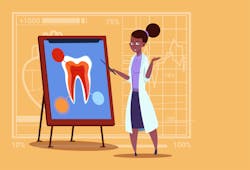3 suggestions to simplify patient education
We all know the look. It's the look that says, “I have no idea what you just said, but I would feel stupid if I told you.”
Periodontal disease, bone loss, plaque biofilm, calculus, inflammation...these are all terms that have become second nature to us, but they leave our patients’ heads spinning. Do not forget: the language we speak is a foreign language to the average person. But this language, despite its complexity, should be taught to patients in understandable terms to help them improve their oral health literacy.
The American Dental Association has defined oral health literacy as the ability for patients to “obtain, process, and understand basic oral health information and services needed to make appropriate health decisions.”1
Hygienists have a responsibility to help each of these outcomes take place. But how can this happen in a less-than-an-hour, jam-packed, infrequent appointment? How can we utilize the little time we have to help our patients become more oral health literate?
Here are three suggestions to help keep the science simple when educating patients about what is happening in their mouths.
Educate your captive audience
Oral health education should be more than a 10-second reminder about flossing as you quickly shove a goodie bag into a patient’s hand on the way out of the op. (We are all guilty of this, right?!) Educating is, after all, part of what the patient is paying for—whether they know it or not. So while you are working in patients' mouths, teach them! Do not under-utilize the precious minutes where you control the conversation. Replace the mindless banter or silence with a "class" on oral health. Tell them that you want to teach them throughout the appointment. Rapport will be built when you take the time to educate your patients. Most will want to listen. I have seen this from personal experience. And remember, keep it simple.
Example: As you start to probe, tell the patient to listen to the numbers you say out loud. Mention that any numbers greater than 4 mm are concerning. Vocalize when you see bleeding or pus. Applying this technique may elicit questions from a patient. This is wonderful and should be welcomed! This also may help them correlate what we are finding in our assessment with what they are feeling. This leads to the next suggestion.
Utilize their senses
Engaging as many senses as possible can help patients in the learning process. This is actually a learning theory implemented by educators for many years! Lawrence Baines suggests that “one of the greatest benefits of using multisensory stimuli is that they have the potential to involve students more fully in the learning experience” because multiple senses are engaged in a lesson.2 There is no better place for patients to have a multisensory experience than in their mouth! Below is an example of multisensory learning in action during a dental appointment.
Example: Use the explorer to draw the patient’s attention to what they feel and hear as the tip bumps over calculus. Then, simply explain what they are feeling. You could say, “Do you feel how my instrument catches there? That is tartar, also known as calculus. It is chalky and hard. Bacteria holds onto tartar and make your gums red and sensitive. When the area is not cleaned, the bone that holds the root of the tooth in your jaw slowly goes away.” After removing the calculus, show the patient what is on the tip of the instrument. Put it on a piece of gauze and hand it to them to look at for a few seconds. This may seem elementary to us, but remember: most of our patients know very little about oral health. When it comes to patient education, simple is better. This leads to the final suggestion.
Use relatable comparisons
Comparisons help keep things simple. When patients connect something with which they have personal experience to their own oral health, they can better understand the role they play in improving or maintaining it.
Example: You could compare plaque to the slimy residue that builds up between the tiles of a shower. Many patients will know from personal experience that the slime does not budge by simply spraying it with cleaner. It needs to be brushed off. Ironically, most people use a toothbrush for this! Similarly, simply rinsing with mouthwash does not remove plaque; it needs to be removed through brushing and flossing.
In this example, comparing plaque to shower slime not only gives the patient something that they can relate to, but helps them understand why brushing is necessary for plaque removal. An added bonus? The patient will be motivated to brush because, well, who wants something that is comparable to shower slime in their mouth?
The takeaway
Aside from helping our patients to learn the basics of oral health, the three suggestions above will help patients understand why we are recommending certain treatments. Patients will feel satisfied that they got the most out of their dental appointments and more prepared (and hopefully motivated) to improve their home oral hygiene care. As hygienists, there will be satisfaction knowing that we made the most of the little time we had with patients and that they left our op knowing a little more than they did before!
References
1. Health literacy in dentistry. American Dental Assocation website. https://www.ada.org/en/public-programs/health-literacy-in-dentistry. Accessed October 23, 2019.
2. Baines L. A teachers guide to multisensory learning: improving literacy by engaging the senses. Alexandria, VA: Association for Supervision and Curriculum Development; 2008.
Rebecca Neilson is a dental hygiene student at Indiana University South Bend.
About the Author

Rebecca Neilson, BS, RDH
Rebecca “Becca” Neilson, BS, RDH, grew up in Provo, Utah. She graduated from Brigham Young University in 2014 with a bachelor of science in biology, and Indiana University South Bend in 2020 with a bachelor of science in dental hygiene. She is happily married and lives in Elkhart, Indiana. Becca’s long-time hobby is arranging flowers, and she currently works as a florist. She thrives on interpersonal relationships and finds satisfaction in helping others learn. You can reach her at [email protected].
Updated August 26, 2020
